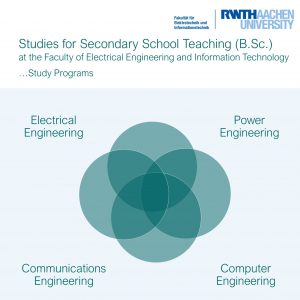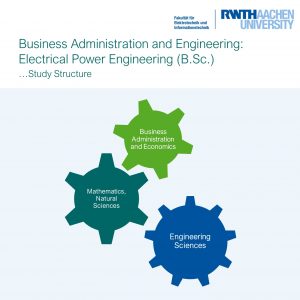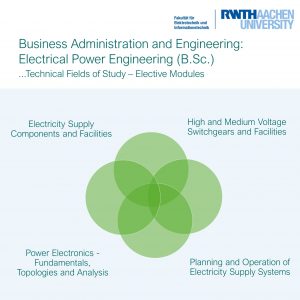Kategorie: ‘SchülerInnen/Studieninteressierte’
Climate protection through electrical engineering – Professor Dirk Uwe Sauer’s lecture at the Children’s University

Kinder im Hörsaal. ©RWTH Aachen University
Whether drought, floods or forest fires – the consequences of global warming are dramatic for nature and people. The countries of the global south are being hit particularly hard, but the effects are also being felt here. We experienced this at the latest with the devastating floods in July 2021. That is why we urgently need to address the issue of climate change.
This is also what Dirk Uwe Sauer, Professor of Electrochemical Energy Conversion and Storage Systems Technology at RWTH Aachen University, is doing. He has been researching new energy systems for over 30 years and advises politicians on the energy transition.
„We see in all places that climate change is happening – with many negative consequences. And we urgently need a radical change in the way we have supplied ourselves with energy so far.“
This does not only affect us adults, but especially the children and young people of today. They will have to live with the limitations that climate change will bring. “I don’t think we should underestimate what children know and what they are capable of,” says Professor Sauer.
It is not too late to make a difference
In his lecture, the physicist not only explained the dangers of climate change, but also made the necessary changes understandable. He used various materials such as videos, slides and interactive presentations to show the physical basics and the possibilities through timely action: “I also want to spread optimism and show that things can also get better than they currently are. Because if we still grab the wheel in time, then we still have the possibility to avoid worse things.” For this to happen, however, society must overcome its fear of new technologies. The professor said that there is too much talk about the risks instead of seeing the opportunities. “And we simply can’t afford that now either.” A ruling by the Federal Constitutional Court in 2021 has obliged politicians, and thus the population, to act more quickly. The slower progress is made, the more the living conditions of the next generations are restricted. That is why the previous federal government tightened the climate protection targets and the Climate Protection Act. “We have the opportunity to achieve these goals. We have the necessary technologies to supply all eight billion people in the world properly with renewable energy,” Sauer said.
Climate change is an important issue that concerns us all. But what does it actually mean and how can we work against it? Professor Sauer explained this to the children in his lecture at the Children’s University on 16 June 2023. He showed them how the earth is warming up and what consequences this has for nature and people. He also presented solutions on how we can protect the climate with renewable energies and new technologies. For example, with solar cells that generate electricity from sunlight, or with electric cars that emit no exhaust gases. Professor Sauer showed the children not only the problems of climate change, but also the opportunities that arise from it. He showed them that we can not only influence the climate with our energy supply, but also promote biodiversity.
„I would like to show the children that, for example, large photovoltaic systems on open fields not only generate electricity, but also create space for extensive agriculture, for insects that can live and flourish in these areas again.“
Climate change is a major challenge that we can only overcome together. For this, we need an awareness of the connections between energy and the environment that starts with children. Another goal of the Children’s University event was to get the children excited about scientific topics. “Physics has the great advantage that it can illustrate things very vividly and also show connections,” said Sauer. Using simple means, Professor Sauer showed where research starts and what possibilities can arise through technical progress.
Source: Aachener Zeitung, 16 June 2023
Encouraging women to take up MINT professions – support for ZDF heute journal

BA student Helena in an interview with the ZDF heute journal team. Photo: C. Antweiler
At the end of January, the team from ZDF heute journal visited the Institute for Communication Systems at RWTH Aachen University for a report. The report provides insights into the topic of “women in MINT subjects”, which are sometimes chosen even less by women and girls, such as mathematics, computer science, natural science and technology. Editor Peter Böhmer from the North Rhine-Westphalia State Studio researched the reasons for the low quota of women at RWTH Aachen University and what approaches could be taken to change this.
Through interviews with various female RWTH students, including our BA student Helena, as well as with Univ. Prof. Dr. rer. nat. Aloys Krieg, Prorector for Teaching, the heute journal team was able to gain an impression. The Institute for Communication Systems and a lecture by Prof. Peter Jax provided the pictorial framework for the report.
You can find the report in the ZDF Mediathek.
Support in Choosing a Degree Programme: Online Workshop of the Student Advice Centre

© Stefan Hense
The Student Advice Centre of RWTH is offering workshop dates in the next few months to support pupils and prospective students in choosing the right degree programme. In small groups, relevant topics are worked on interactively, such as decision-making processes, exploration of interests and self-examination, as well as decision-making aids for the choice of degree programme.
Workshop dates:
Fri, September 9, 2022, 10am to 4pm
Wed, October 5, 2022, 10am to 4pm
Thu, November 10, 2022, 10am to 4pm
Thu, December 8, 2022, 10am to 4pm
Fri, January 20, 2023, 10am to 4pm
In the workshops, participants will be given tools that can support them in their own study orientation. Participation is particularly useful if it is voluntary and there is a willingness to work out one’s own study decision. Please note that the workshop will be held in German.
Participation is free of charge. All information on registration and further details can be found on the workshop page of the Student Advice Centre.
Exhibition at the OECHER LAB

© Christiane Antweiler
The Institutes of Communications Engineering and Communication Systems of RWTH Aachen have participated in the Future Space “Smarte Kids – Smarte Stadt” of the OECHER LAB with the subject area of communication systems. In May and June 2022, this Future Space will present exhibits from the STEM field. In addition to communication systems, information can also be obtained on the topics of virtual reality, robotics & microcontrollers and CO2 meters in a manner appropriate to the target group.
The exhibit of the RWTH institutes uses a video to show the performance of three generations of video coding methods that have been developed in recent years. An audio demonstration takes visitors on a short journey through the development of telephony. The goal of current research is spatial telephony, which is also exemplified in the audio track.
Discover our exhibits until the end of June in the OECHER LAB, Kapuziner Karree, Kapuzinergraben 19. For more information, please visit the OECHER LAB website.

© Christiane Antweiler
Study worldwide – the virtual fair on March 25, 2022

Copyright: Deutscher Akademischer Austauschdienst e.V. (DAAD)
The online fair “Studying worldwide – the virtual fair” will take place again this year. On March 25, 2022, students can get personal advice on studying or doing internships abroad. There will also be a wide-ranging program on financing options and recommended planning steps. Testimonials from former exchange students will give you personal insights that could be valuable for your own planning process.
- When? March 25, 2022, from 12:30pm to 4:30pm.
- Where? Online.
For more information and to register for free, visit the “Studying Worldwide” exhibition page.
Students of the Bachelor’s program Business Administration and Engineering- Electrical Power Engineering
What would a study programme be without students?
We asked Viviana, a student in Bachelor Business Administration and Engineering – Electrical Power Engineering, to describe the course from her personal point of view.
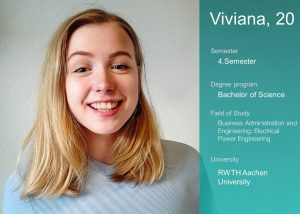
Why did you decide to study Business Administration and Engineering: Electrical Power Engineering?
For me, the interdisciplinarity of the course was particularly attractive. In addition, I find the topic of energy system transformation very exciting. Electrical power engineering enables the combination of my scientific curiosity and my idealistic ideas.
Why did you decide to study this course at the RWTH Aachen University?
The RWTH immediately caught my eye because of its good reputation for the course. I also find Aachen’s geographical location very attractive, with fast train connections to Cologne, Amsterdam and even Paris.
What has been your greatest sense of accomplishment and your greatest challenge in your studies so far?
My biggest challenge was that I had deselected physics in the academic secondary school and therefore had to do some catching up in the beginning. However, this is also my greatest sense of achievement. It showed me how much you can teach yourself if you are interested in a certain topic.
Are you interested in the study programme Business Administration and Engineering – Electrical Power Engineering?
Here you can find further information
Secondary School Teaching & Technology Education Gymnasium and Gesamtschule Teacher B. Sc.
You can choose the following courses of study:
Studies for Secondary School Teaching:
- Electrical Engineering
- Power Engineering
- Communications Engineering
- Computer Engineering
Technology Education Gymnasium and Gesamtschule Teacher
- Technology
After the successful completion of the bachelor’s program you can follow up with the Master of Education (4 semester). After this degree you will have access to the preparatory service (formerly “Referendariat”).
Job prospects?
If you have studied engineering sciences “on a teaching profession”, you are not restricted to school. After graduation, you can also find interesting entry-level positions, for example in industry. Your particular strength is that you have trained in the teaching of complex technical contexts during your studies.
You can find more information on our website.
Electrical Engineering with Orientation Semester (ETOS) B.Sc.
The course of study is aimed at students who wish to gain a realistic insight into the electrical engineering course of study at both universities to be able to make their individual study decision for a type of university and possibly a later specialization.
The joint Bachelor’s degree course “Electrical Engineering with Orientation Semester” of the FH Aachen and RWTH Aachen University is an independent course of study consisting of a joint first semester at both universities and a subsequent partial course of study at one of the two universities.
The partial courses of studies correspond essentially to the courses of studies of the participating departments and faculties. The standard period of study comprises seven semesters (3.5 years) full-time, including the preparation of the Bachelor thesis.
You can find more information on our website.
Business Administration and Engineering – Electrical Power Engineering B. Sc.
This interdisciplinary course of study comprises:
- Economics
- Mathematics, Natural Sciences
- Engineering Sciences
After acquiring a broad basic knowledge in these areas, from the 5th semester onwards you can
then choose from various technical subjects with a focus on electrical power engineering:
- Power electronics – basics, topologies and analysis
- Planning and operation of electricity supply systems
- High- and medium-voltage switchgear and installations
- Electricity supply components and systems
Career prospects?
Since the supply of affordable and sustainably produced energy is of global relevance,
industrial engineers have good chances on the job market – both nationally and internationally.
You can find more information on our website.
Students of the Bachelor’s program Electrical Engineering, Information Technology and Computer Engineering
What would a study programme be without students?
We asked Sarah, a student in Bachelor ET, IT, TI, to describe the course from her personal point of view.
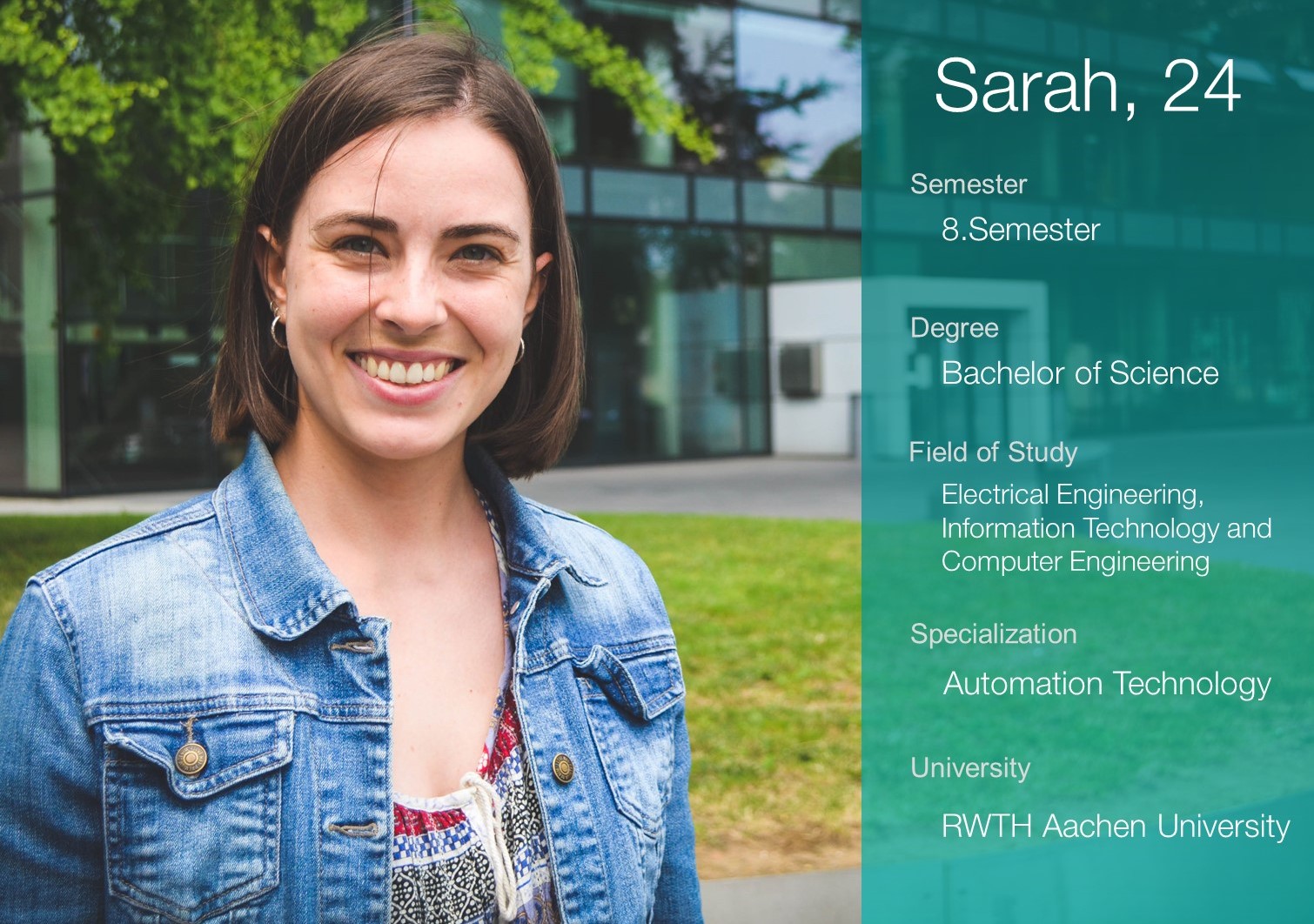
Why did you decide to study Electrical Engineering, Information Technology and Computer Engineering?
I have always had a great interest in natural sciences and when I was choosing my studies, I was particularly attracted to Electrical Engineering.
Why did you decide to study this course at the RWTH Aachen?
On the one hand, my grandparents have already studied in Aachen and Aachen is not so far away from home. And on the other hand I followed the good reputation of the RWTH.
Why did you choose the specialization in automation technology?
I have many interests and could therefore not yet commit myself to a deepening. That’s why I choose automation engineering as my master’s degree. In automation engineering you can stay broadly diversified and combine modules from other specialisations to suit your own interests.
What has been your greatest sense of accomplishment and your greatest challenge in your studies so far?
The greatest successes so far have been passing my last Bachelor exam and handing in my Bachelor thesis. Every semester, the exam phase was challenging, in which you want to stay mentally as healthy as possible to withstand the pressure, but you have to push yourself enough to pass the exams.
You are interested in the study course Electrical Engineering, Information Technology and Computer Engineering?
Here you can find further information




